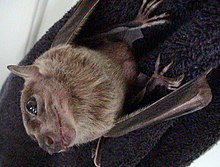Rousettus aegyptiacus
| Egyptian fruit bat | |
|---|---|
 |
|
| Scientific classification | |
| Kingdom: | Animalia |
| Phylum: | Chordata |
| Class: | Mammalia |
| Order: | Chiroptera |
| Family: | Pteropodidae |
| Subfamily: | Pteropodinae |
| Genus: | Rousettus |
| Species: | R. aegyptiacus |
| Binomial name | |
|
Rousettus aegyptiacus (Geoffroy, 1810) |
|
 |
|
| Egyptian rousette range | |
The Egyptian fruit bat or Egyptian rousette (Rousettus aegyptiacus) is a species of Old World fruit bat.
Egyptian fruit bats are found throughout Africa, except in the desert regions of the Sahara, and throughout the Middle East, as far east as Pakistan and northern India. Due to its extensive geographic range, and relatively large wild population, Rousettus aegyptiacus does not hold any specific conservation status.
The Egyptian fruit bat is small compared to some of its megachiropterid relatives. Its wingspan averages 60 cm (2 ft), and body length around 15 cm (6 in). Its weight is typically around 160 g (5.6 oz). Males are larger than the females and can be easily distinguished by their large scrotum. This bat is typically light brown in color, with darker brown wings. It has large, pointed ears, dark eyes, and a long dog-like muzzle - which sometimes leads it to be referred to as a flying fox. Its fur is very soft, and the wings feel like pantyhose.
Like many bats, Egyptian fruit bats are nocturnal. They spend their days roosting in trees or caves, often with large groups of other bats, sometimes numbering in the thousands. They emerge from the roost to forage for food in the late evening, and return just before dawn. They hang upside down, with their wings folded closely around their bodies. Egyptian fruit bats, along with other species in the genus Rousettus, are the only megachiropterid bats to use echolocation, which they accomplish by emitting a series of sharp clicks with their tongues. The clicks are normally slow and constant, and speed up dramatically when the bats approach an object. They also make use of a range of vocalizations for communication, including grunts and screeches. As a result, a large roosting colony can be a deafening cacophony.
...
Wikipedia

